Index
Presentation
If you’re looking for a succulent that enchants with its elegance and simplicity, Crassula Perforata is a captivating choice. Originally from South Africa, this succulent belonging to the Crassulaceae family is prized for its spirally arranged triangular leaves and protruding red edges, creating an intriguing geometric pattern. Also known as “String of Buttons” due to the arrangement of its leaves, Crassula Perforata is a charming addition to any succulent collection, standing out for its unique shape and easy care.
Meaning of Crassula Perforata
In addition to its aesthetic beauty, Crassula Perforata carries a symbolic meaning. Its spirally arranged leaves represent harmony and balance in nature, while the reddish edges symbolize energy and vitality. Growing this succulent not only adds a decorative touch to your environment, but also carries with it a message of serenity and vitality that transcends its physical presence.
| Common Name | String of Buttons |
| Botanical Name | Crassula Perforata |
| Family | Crassulaceae |
| Plant Type | Succulent |
| Adult size | About 30 cm tall |
| Sun Exposure | Direct to partial sunlight |
| Soil type | Well-drained |
| soil pH | Slightly acidic to neutral |
| Flowering Season | Spring to Summer |
| Flower Color | Yellow to Orange |
| Native Area | South Africa |
| Toxicity | Not Toxic |
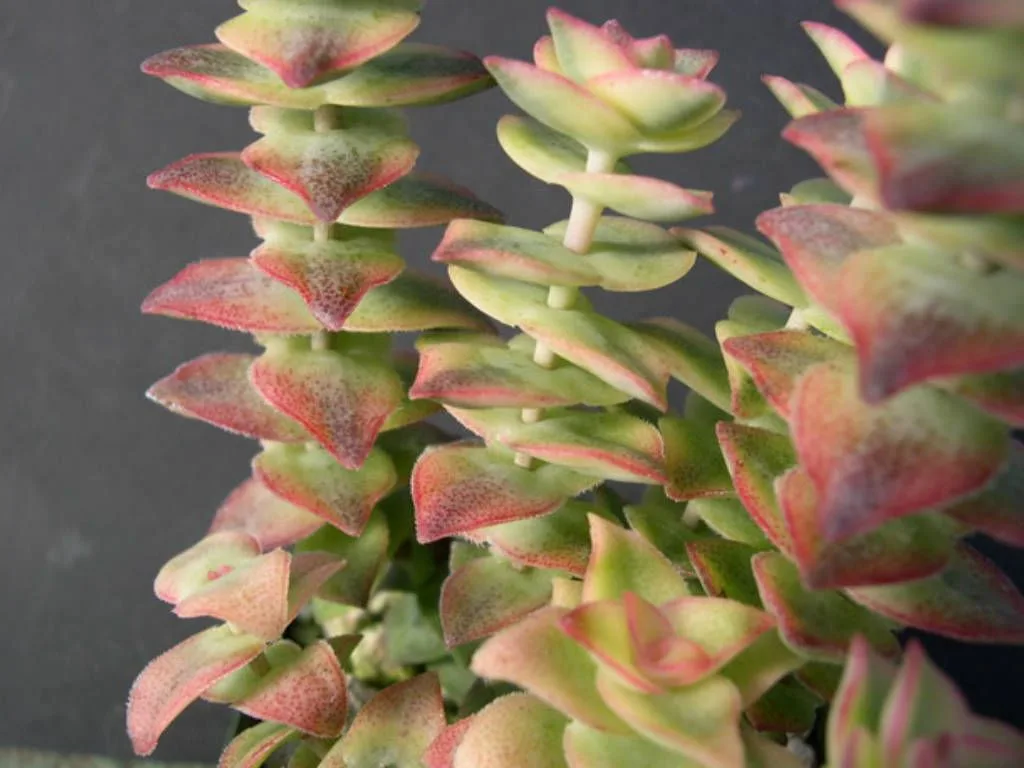
How to Care for Crassula Perforata
Light: Proper Lighting for Optimum Shine
When caring for Crassula Perforata, light plays a crucial role in its development. Position it in a spot with direct to partial sunlight, ensuring that it receives the right amount of brightness to keep its leaves healthy. Avoid prolonged exposure to intense sunlight to prevent damage.
Soil: Well-Drained for Prosperity
Soil is a key element in the successful cultivation of Crassula Perforata. Use well-drained soil, preferably a specific mix for succulents. This prevents water from accumulating in the roots, preventing problems such as root rot.
Water: Moderate Watering for Optimal Balance
Water should be supplied sparingly. Allow the soil to dry out completely between waterings, avoiding excess moisture that can harm the plant. Crassula Perforata is adapted to drier conditions, and a cautious approach to watering is essential.
Temperature and Humidity: Comfortable Environment to Thrive
Maintain a moderate temperature for Crassula Perforata, between 18°C and 24°C. This succulent is hardy, but avoid prolonged exposure to extreme temperatures. As for humidity, it thrives in environments with moderate humidity, adapting well to different conditions.
Fertilizing: The Right Nutrients for Healthy Growth
When considering fertilization, provide nutrients during the growing season using a balanced fertilizer. Avoid excess and follow the product’s instructions. Proper fertilization will contribute to the healthy growth and vitality of Crassula Perforata.
By following these care guidelines, you’ll be providing your Crassula Perforata with the ideal environment to thrive, displaying its unique beauty and remarkable resilience.
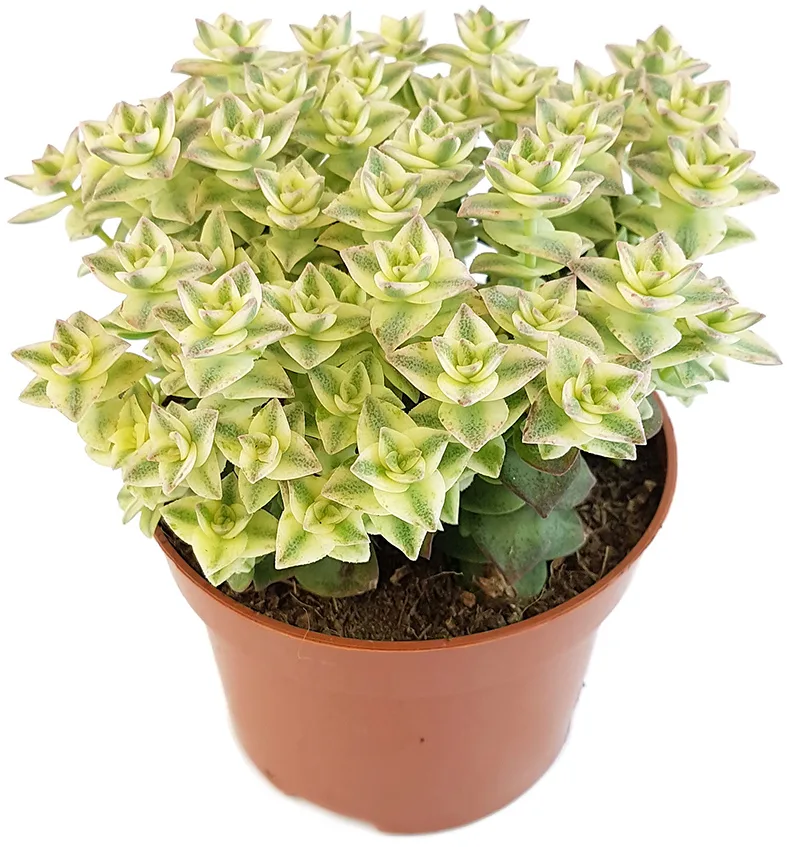
How to grow Crassula Perforata
To expand your Crassula Perforata collection, propagation by seedling is an exciting process. Follow these steps to ensure successful reproduction:
- Healthy Choice: Select a healthy, mature mother plant to ensure vigorous seedlings. Make sure the plant is free of pests and diseases.
- Soil Preparation: Use well-drained soil similar to that recommended for growing Crassula Perforata. Provide a favorable environment for the roots of the seedlings to develop.
- CarefulRemoval: Carefully remove a healthy leaf from the mother plant. Make sure to include part of the stem to increase the chances of successful propagation.
- Proper Drying: Allow the cuttings to air dry for a day or two to form a protective layer at the base of the leaf.
- Conscientious Planting: Plant the cuttings in prepared soil, lightly burying the base of the leaf. Avoid burying too deeply.
- Moderate watering: After planting, water sparingly to moisten the soil. Avoid over-saturation.
- Initial care: Keep the cuttings in a place with indirect light until they develop roots. After rooting, transfer them to the desired location.
How to plant Crassula Perforata
When planting Crassula Perforata, attention to detail is essential to ensure a smooth adaptation and lush growth:
- Site Selection: Plant the Crassula Perforata in a location with direct to partial sunlight, replicating its natural environment.
- Suitable Soil: Use well-drained soil, maintaining the texture recommended for succulents. Avoid water accumulating in the roots.
- Controlled watering: Maintain a moderate watering schedule, allowing the soil to dry out between waterings. Avoid overwatering to prevent humidity problems.
- Protection against extremes: Safeguard the plant against extreme temperatures, especially frosts. Crassula Perforata prefers moderate environments.
- Appreciation of Growth: By following these guidelines, your Crassula Perforata will thrive, revealing its unique beauty and adding a special touch to your garden or indoor space.
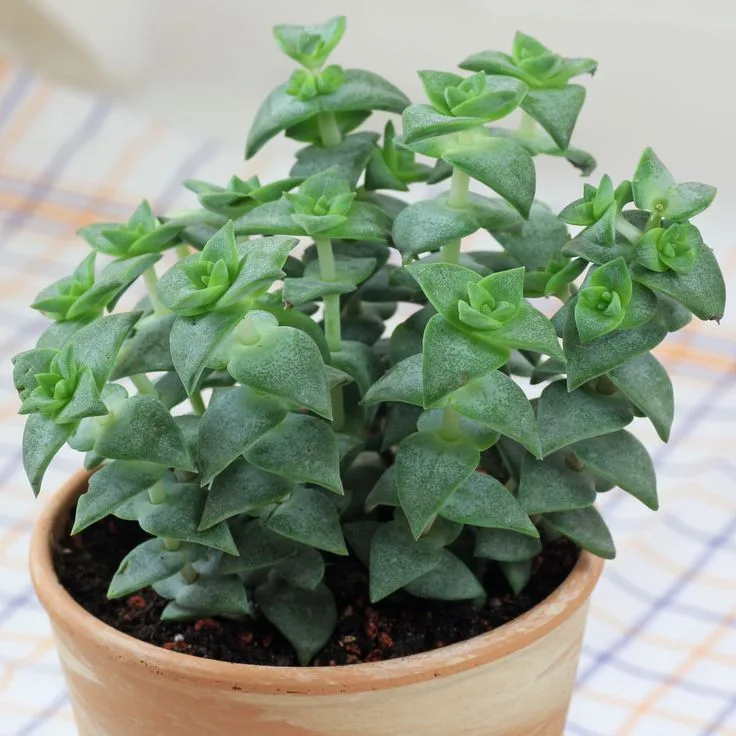
Most common pests and diseases
When caring for Crassula Perforata, it’s crucial to be aware of the possible pests and diseases that can affect this charming succulent. Here is a detailed list of the most common threats, accompanied by effective solutions to keep your plant lush:
- Mites: Small mites can harm Crassula Perforata, causing damage to the leaves. Use a water spray to remove them or consider natural solutions, such as neem oil, for control.
- Mealybugs: Sap-sucking insects can leave white spots on the plant. Remove them manually or use a solution of water and neutral soap to eliminate them.
- Root rot: Excess moisture can lead to root rot. Reduce watering, ensure well-drained soil and adjust the environment to avoid excessively humid conditions.
- Leaf spots: Dark spots on the leaves can indicate excess moisture. Adjust watering practices and provide good air circulation to prevent fungal problems.
Common Problems and Their Solutions
In addition to pests and diseases, some common problems can arise when growing Crassula Perforata. Here are some typical situations and their solutions:
- Wilted leaves: If the leaves are wilted, review the amount of water supplied. Adjust watering as necessary, avoiding both too much and too little.
- Yellowing leaves: Yellowing leaves may indicate too much sun. Move the plant to a location with more diffused light.
- Slow growth: Slow growth can be the result of a lack of nutrients. Fertilize the plant during the growing season with a balanced fertilizer.
- Changesin flower color: Changes in flower color can be influenced by the intensity of the light. Adjust the sun exposure to maintain the desired color.
By paying attention to these signs and applying the right solutions, you can overcome the common challenges in growing Crassula Perforata, ensuring a healthy and vibrant plant.
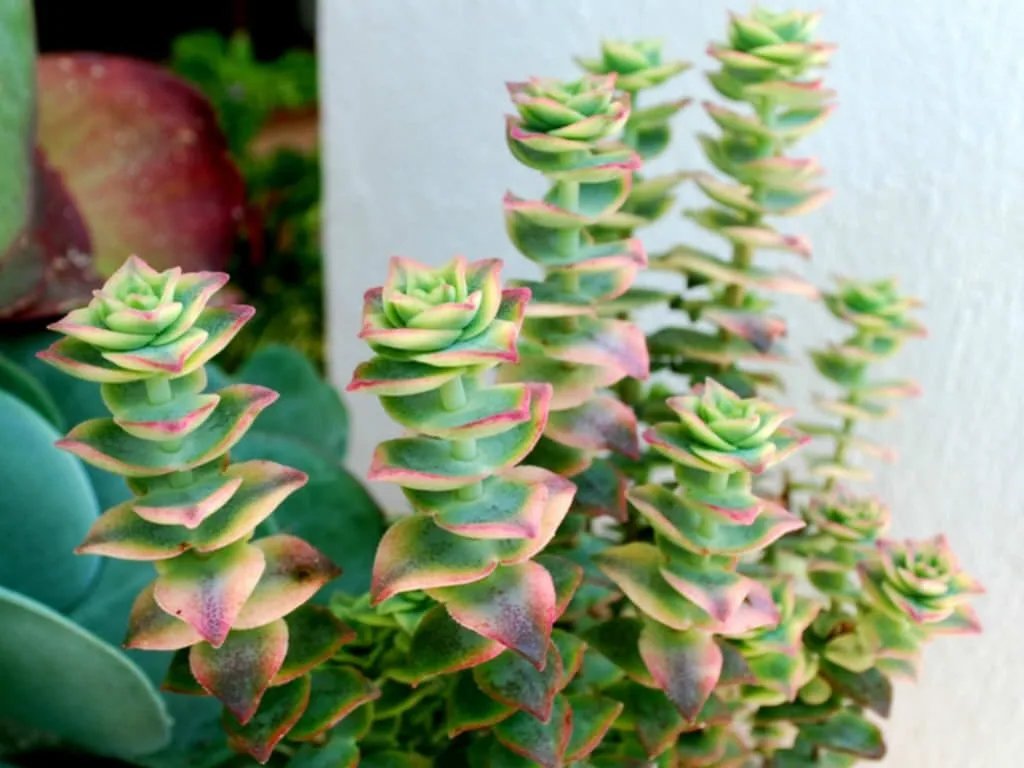
Curiosities and myths
Discover the fascinating facts and dispel the myths surrounding Crassula Perforata. Knowing more about this succulent not only makes it more intriguing, but also enhances your appreciation for this botanical gem.
Surprising facts about Crassula Perforata
- Unique Growth Pattern: Crassula Perforata grows in a spiral pattern, displaying leaves arranged in a peculiar way. This arrangement not only makes it visually unique, but also optimizes the absorption of sunlight.
- Drought resistance: Adapted to arid environments, Crassula Perforata is notable for its drought resistance. Its succulent leaves store water, allowing it to survive in drier conditions and require less watering.
- Starry flowering: During spring and summer, Crassula Perforata produces small star-shaped flowers, adding a charming touch to its overall appearance.
Dispelling Common Myths about Crassula Perforata
- Unlimited Growth: Contrary to the myth that Crassula Perforata grows unlimitedly, it has a controlled adult size, making it manageable for indoor and outdoor spaces.
- Extreme Sun Tolerance: Although it prefers direct to partial sunlight, Crassula Perforata can suffer from prolonged exposure to intense sunlight. Balancing the intensity of the light is essential.
- Adaptation to any soil: Despite its resistance, Crassula Perforata thrives in well-drained soil and benefits from a specific mix for succulents. The choice of soil is essential for its healthy development.
Exploring these curiosities and dispelling myths provides a more complete perspective on Crassula Perforata, highlighting its uniqueness and adaptability. By better understanding this succulent, you’ll be better prepared to cultivate an ideal environment for its healthy flowering.
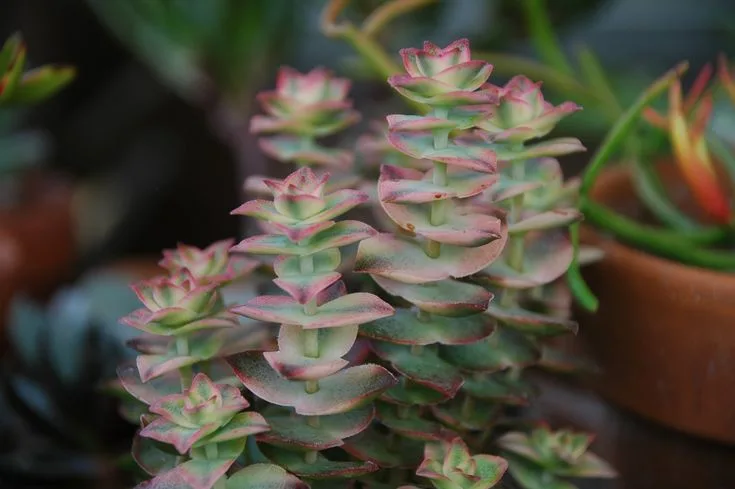
Conclusion
By exploring the fascinating universe of Crassula Perforata, we immerse ourselves in a landscape of curiosities and myths that add layers of appreciation to this unique succulent. From its spiral growth pattern to its drought resistance and starry flowering, each characteristic reveals the complexity and adaptability of this enchanting plant.
We debunk common beliefs such as unlimited growth and extreme sun tolerance, learning that despite its resilience, Crassula Perforata thrives best with specific care. Choosing the right soil, paying attention to sun exposure and understanding its particular needs results in a vibrant and healthy Crassula Perforata. Growing this succulent is not only about creating a visually captivating garden, but also about embarking on a journey of discovery and understanding of the incredible diversity of the succulent kingdom. By unraveling its mysteries, we encounter not just a plant, but a true masterpiece of nature.
Frequently Asked Questions
How to care for a Crassula Capitella?
To care for Crassula Capitella, also known as “Campfire,” it is essential to provide similar conditions to succulents in general. Place the plant in a spot with direct or partial sunlight and use well-drained soil. Water moderately, allowing the soil to dry out between waterings. Avoid excess moisture to prevent problems such as root rot. By following these basic guidelines, the Crassula Capitella will thrive, showing off its colorful and attractive leaves.
How to care for Crassula arborescens?
Crassula arborescens, also known as the “Silver Dollar Plant,” requires specific care for healthy growth. It prefers direct to partial sunlight and well-drained soil. Water moderately, allowing the soil to dry out between waterings. This succulent is hardy and adapts well to dry conditions. By providing a bright environment and taking care with watering, you promote the vigorous development of Crassula arborescens, enjoying its rounded, silvery leaves.
How to look after Crassulas?
General care for Crassulas involves principles common to many succulents. They prefer direct to partial sunlight, well-drained soil and moderate watering. Avoid excess moisture to prevent root problems. However, it’s important to recognize that different species of Crassula may have slightly different needs. Therefore, when growing a variety of Crassulas, it is useful to know the specific characteristics of each plant and adjust care as necessary.







